In Memoriam
William A. Bernhard, Ph.D. (1942 - 2012)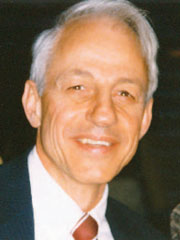
Dr. William A. Bernhard, Professor of Biochemistry and Biophysics at the University of Rochester, and past president of the Radiation Research Society, died peacefully, May 9 at his home in Mendon, NY. Dr. Bernhard was an internationally known expert on the effects of ionizing radiation on the chemical structure of DNA.
Dr. Bernhard earned his B.S. degree in Physics at Union College in 1964, and his master’s and doctoral degrees in Biophysics at Penn State University in 1966 and 1968. Dr. Bernhard then received postdoctoral training at the Argonne National Laboratory from 1968–1970. He joined the faculty of Biophysics at the University of Rochester as an assistant professor in 1970 with an NIH Career Development Award. He was appointed professor of Biophysics in 1985. He served as associate chair or co-chair of the Department of Biochemistry and Biophysics from 1996 to 1998.
Dr. Bernhard was a biophysicist of the highest order, working at the forefront of understanding how radiation damages our genetic material. His unique command of both the biological and physical aspects of radiation damage earned him the respect and recognition of colleagues worldwide. The longevity of his research program, funded by the National Cancer Institute for 37 consecutive years, and the successful careers of his many trainees are testaments to the consistent high quality of his work, the high regard his peers, and his commitment to training future scientists. Bill also was a wonderful person and colleague. His kindness to his colleagues and passion for his work made him a trusted friend and ideal colleague.
His renowned research program has focused on understanding the physical and chemical processes by which radiation affects biomolecules, especially DNA. His results have helped guide industrial and government policies regarding radiation risk assessment and have provided critical details to predict the biological consequences of radiation and understand DNA damage mitigation and repair processes.
Throughout his career, Bill was committed to mentoring and developing young scientists, and he felt strongly about investing in people and their careers. Bill was the Ph.D. thesis supervisor for 14 students. He had 9 post-doctoral students, and worked with 2 research assistant professors. Many of these former co-workers have moved on to academic positions and are doing research in radiation damage studies in DNA.
Bill’s contributions to radiation chemistry went beyond his published works. His presentations at meetings and conferences were always models of clarity and insight. It was impossible to attend one of his talks without learning something new. This, in a way, was also a show of respect and affection for both his colleagues and for his field of research.
Bill was a biophysicist of the highest order, working at the forefront of understanding how radiation damages our genetic material. His unique command of both the biological and physical aspects of radiation damage earned him the respect and recognition of colleagues worldwide, said Jeffrey J. Hayes, Ph.D., chair of the Department of Biochemistry and Biophysics. The longevity of his research program, funded by the National Cancer Institute for 37 consecutive years, and the successful careers of his many trainees are testaments to the consistent high quality of his work, the high regard his peers, and his commitment to training future scientists. Bill also was a wonderful person and colleague.
For more information on Dr. Bernhard and his research please continue reading the Radiation Research article, browse the list of his publications, and visit the William A. Bernhard Memorial Lab.
Philip J. Fay, Ph.D. (1953 - 2014)
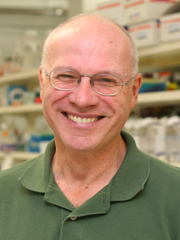
We are very saddened to relay the passing of our colleague and friend Phil Fay, Ph.D, Professor of Biochemistry and Biophysics. Phil passed away Wednesday June 25th after a long and courageous battle with cancer. His incredible strength of character through a most difficult time remains an inspiration to us all.
Calling hours were 3-6 pm Sunday June 29th at Anthony Funeral Chapel, Brighton, 2305 Monroe Ave. Rochester, NY, US, 14618. His Funeral Mass was 11 am Monday June 30th at St. Louis Church, 64 S Main St, Pittsford. Burial followed at White Haven Cemetery, 210 Marsh Road Pittsford, with a reception at the Country Club of Rochester. His Obituary can be found here.
Drs. Sriram Krishnaswamy and Peter Lollar and Y, from X and Y recently wrote a fitting tribute to our friend and colleague, Dr. Philip Fay, who passed away June 25, 2014 after a long battle with cancer. The two are researchers working in the same field as did Dr. Fay and published the tribute in Thrombosis and Haemostasis, a leading journal in the field. You can read the tribute here.
Among numerous awards and significant accomplishments in an esteemed career, Phil and research assistant professor, Hironao Wakabayashi, M.D., Ph.D. were recently nominated for the 2014 RIPLA Distinguished Inventor of the Year Award given by the Rochester Intellectual Property Law Association (RIPLA). They were nominated for their work in the field of Factor VIII technology for treatment of hemophilia A patients.
On July 8th, 2014 the flags at the University of Rochester were lowered in honor of Dr. Fay.
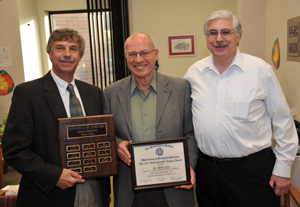
Dr. Fay (middle) when he received the
University of Buffalo, Department of Biological
Sciences 2012 Distinguished Alumni Award.
Philip A. Knauf, Ph.D. (1942 - 2006)
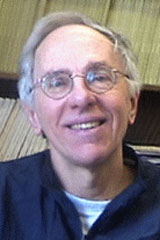
Philip A. Knauf, Ph.D., a distinguished Professor in the Department of Biochemistry and Biophysics at the University of Rochester Medical Center, died Sunday, June 25, after a brave fight with lymphoma. He was 64.
In 26 years at the University of Rochester Medical Center, Knauf was a respected teacher, biophysicist and leader in the Faculty Senate, of which he was co-chair in 2003-2004. Research colleagues, here and worldwide, were impressed by his consistent ability to create new ways to study the fundamental function of red and white blood cells. Fellow senators praised his leadership, his profound respect for other faculty and his love for the University.
An outstanding scholar from early on, Knauf graduated summa cum laude from Boston College in 1963. After completing biophysics training at the Universitat des Saarlandes in Homberg, Germany, in 1966, Knauf earned his Ph.D. in Biophysics from the University of Rochester in 1970. He then spent the 1970s as an associate professor within the University of Toronto departments of Medical Biophysics and Radiation Biology, before returning to University of Rochester Medical Center as an associate professor in the Department of Biophysics in 1980. He became a full professor in 1984, and had been here since.
As a researcher, Knauf was a pure basic scientist. His lab was primarily concerned with understanding how red and white blood cells transport charged particles across cell membranes, a job essential to their healthy function. He used state-of-the-art measurement techniques, some of which he invented, to identify the structures of proteins that transport negatively charged particles (negative ions).
For more information on Dr. Knauf and his research please continue reading the URMC Newsroom article.
Christopher W. Lawrence, Ph.D. (1934 - 2019)
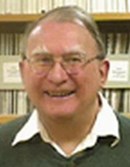 Christopher Lawrence, Ph.D., Professor Emeritus of Biochemistry and Biophysics at the University of Rochester, died on 14th September 2019 in Rochester NY. He was born in London, England in 1934. Chris earned his Bachelor of Science degree in Agricultural Botany from the University of Aberystwyth, and subsequently gained a Ph. D. in Genetics at the University of Birmingham. Chris then moved to the Atomic Energy Research Establishment in Wantage, UK. There he examined the effects of radiation damage, primarily on plants. Seeking more tractable research models, in 1969 he came to Rochester on a sabbatical visit to learn yeast genetics in the laboratory of the late Fred Sherman, one of the founders of the yeast genetics field. Shortly thereafter, he was offered a faculty position in what was then the Department of Radiation Biology and Biophysics at the University of Rochester. As noted in a letter dated December 16th, 1969 by William F. Neuman, Chair of the Radiation Biology and Biophysics Department, “He proved to be a fine person, an excellent scholar and lecturer, and a good investigator in an area (cellular radiobiology) that we’re trying to build.” He remained at the University of Rochester from 1969 until his retirement in 2005, being promoted to the rank of Professor in 1982. Yeast as a model organism clearly suited him; not only was it a preferred model system for the rest of his career, but he taught for several years in the Cold Spring Harbor yeast genetics course with Fred Sherman and Gerry Fink.
Christopher Lawrence, Ph.D., Professor Emeritus of Biochemistry and Biophysics at the University of Rochester, died on 14th September 2019 in Rochester NY. He was born in London, England in 1934. Chris earned his Bachelor of Science degree in Agricultural Botany from the University of Aberystwyth, and subsequently gained a Ph. D. in Genetics at the University of Birmingham. Chris then moved to the Atomic Energy Research Establishment in Wantage, UK. There he examined the effects of radiation damage, primarily on plants. Seeking more tractable research models, in 1969 he came to Rochester on a sabbatical visit to learn yeast genetics in the laboratory of the late Fred Sherman, one of the founders of the yeast genetics field. Shortly thereafter, he was offered a faculty position in what was then the Department of Radiation Biology and Biophysics at the University of Rochester. As noted in a letter dated December 16th, 1969 by William F. Neuman, Chair of the Radiation Biology and Biophysics Department, “He proved to be a fine person, an excellent scholar and lecturer, and a good investigator in an area (cellular radiobiology) that we’re trying to build.” He remained at the University of Rochester from 1969 until his retirement in 2005, being promoted to the rank of Professor in 1982. Yeast as a model organism clearly suited him; not only was it a preferred model system for the rest of his career, but he taught for several years in the Cold Spring Harbor yeast genetics course with Fred Sherman and Gerry Fink.
At Rochester, his primary interests were in understanding how ultraviolet (UV) radiation and chemical DNA damaging agents lead to genetic mutations, and elucidating the cellular factors and activities involved in dealing with such damage. Over time, he focused on the mutagenic RAD6 pathway in DNA repair. One significant question that he examined with respect to this pathway was whether all of the players in UV mutagenesis were known. His laboratory described novel mutations in four complementation groups (rev4 – rev7) that affected UV-induced or chemical (nitrosoguanidine, ngm2) mutagenesis. Three of the new rev mutants were subsequently characterized in his laboratory: the REV7 gene encoded a fairly small protein with no similarity to other proteins known at the time, the rev6 mutation was shown to be an allele of POL30, encoding PCNA, and preliminary data indicated that rev5 is an allele of POL32. About 30 years ago, his lab sequenced the REV3 gene and predicted from its sequence that it encoded a DNA polymerase. Attempts to demonstrate its biochemical activity floundered until Chris and his research group, in collaboration with David Hinkle’s laboratory, demonstrated that Rev3p formed a complex with Rev7p, leading to dramatic changes in the tractability of Rev3p. They further demonstrated that Rev3p-Rev7p formed the core of what became known as DNA polymerase ζ, a specialized DNA polymerase that cells use to overcome UV damaged DNA. In this same period, Chris and collaborators demonstrated that Rev1p was also a dCMP transferase. These discoveries aided in the description of families of novel polymerases that deal with various forms of damaged DNA, the results of which were published several landmark papers, including papers in Nature, Science, and The Proceedings of the National Academy of Science, USA (Nelson et al., 1996 Nature 382:729; Nelson et al., 1996 Science 272:1646; Gibbs et al., Proc. Nat’l Acad. Sci. 95:6876).
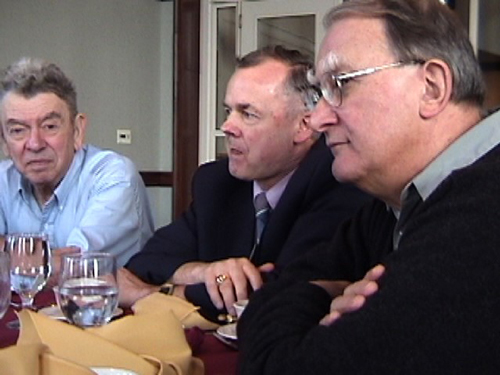
Dr. William Simon, Dr. George Kimmich, and Dr. Christopher Lawrence (from left) in November 2001.
Another area of interest to Chris was whether specific DNA lesions caused different types of mutations. To address these questions, Chris’ lab, including his collaborator Jean LeClerc, pioneered an approach that enabled placement of highly purified DNA fragments containing specific lesions in contexts where they were protected from other repair mechanisms. The initial system employed “gapped-circular” constructs, wherein the replicative form of the phage M13-mp7 included a short single-stranded region in which lay the lesion; thus the only way in which the phage could replicate was to bypass the damage. By analyzing the phage obtained, it was possible to determine the efficiency of bypass, the frequency of mutation, and the spectrum of mutations resulting from specific damaged bases. It was found that in E. coli the mutation frequencies differed between lesions and were further altered by the induction of the SOS response. A modified M13 phage enabled these studies to be extended into S. cerevisiae, leading to the unexpected observation that the bypass frequencies and mutation spectra were significantly different. Moreover, using specific mutants, Chris and his colleagues determined that different DNA polymerases preferentially bypassed different lesions.
The period in which these polymerases were described was arguably the most exciting of his career, particularly when coupled with the differential mutagenicity of each type of DNA lesion. He saw that a field in which he had labored for many years was transformed from a quiet backwater by an explosion of new information. Chris’ research figured prominently in this transformation.
Chris had very few students; he was a very low-key speaker and his lectures and other presentations tended to be very dry. This put him at a disadvantage compared to other more exuberant teachers and coupled with his expectation of high standards from his associates tended to make students wary of joining his laboratory. Yet if one measured up to his expectations, one could not find a better colleague or mentor. He was unstinting in giving credit to his coworkers. He was a great believer in the greater good; it was understood by members of the lab that if a request for plasmids, strains or reagents was received, that material should be sent out at the earliest possible opportunity, even if it was to a direct competitor.
Fred Sherman, Ph.D. (1932 - 2013)
Courtesy, URMC Newsroom & Rochester Democrat and Chronicle

Fred Sherman, Ph.D., an internationally recognized scientist and a faculty member at the University of Rochester Medical Center since 1962, died on September 16 at the age of 81. Sherman, who served as chair of the Department of Biochemistry and then the merged Department of Biochemistry and Biophysics from 1982 until 1999, was one of only three URMC faculty members appointed to the prestigious National Academy of Sciences.
Sherman performed groundbreaking research on the structure of genes and the effects of genetic mutations on proteins in yeast. He was also a proponent of the use of baker's yeast as a genetic model system. Research using yeast is now conducted at virtually all research centers worldwide, largely due to Sherman’s efforts and his teaching of many leaders in the field.
Fred Sherman was responsible for countless scientific advancements in the field of molecular biology — and also certain anti-food fight prohibitions at a summer research institute on Long Island. Born in Minnesota, Sherman arrived in Rochester in 1962 and never left, retiring well into his sixth decade of teaching and research. He was best known for his mind but loved for his sense of humor.
His famous yeast seminar at Cold Spring Harbor on Long Island was an essential crash course for young scientists in the field — and also a time for late night dancing and enough dining room shenanigans that cream pies were ultimately stricken from the menu in an attempt to curb the culinary warfare. He did science with a flair, said his wife and URMC colleague, Elena Rustchenko-Bulgac. He'd always say, 'Let’s dance.' And that was the thing I’ve wanted to do since I was a child, so it was perfect.
It’s hard to overstate Fred’s contribution to modern genetics. His insights into how genetic mutations affect protein coding and his foresight of the utility of the yeast system quite literally changed the course of biological research, said Jeffrey J. Hayes, Ph.D., chair of Biochemistry and Biophysics at URMC. Beyond his scientific accomplishments, Fred’s quick wit and sense of humor were legendary. It was always enjoyable to be in a room with Fred. He will be terribly missed.
- For more information on Dr. Sherman and his research please continue reading the D&C article as well as Science Magazine's retrospective and browse the list of his publications.
- In an article appearing in the March-April 2014 Rochester Review magazine, Mark Dumont, Professor of Biochemistry & Biophysics, pays tribute to Fred’s life and work.
- Gerald Fink's tribute to Fred Sherman, from the Yeast Genetics Meeting from July 2014, can be viewed on YouTube.
- Please also see Fred's collection of Yeast-Genetics inspired T-shirts.
Below you will find links to two of Dr. Sherman's books.
An Introduction to the Genetics and Molecular Biology of the Yeast Saccharomyces cerevisiae
Modified from: F. Sherman, Yeast genetics.
The Encyclopedia of Molecular Biology and Molecular Medicine,
pp. 302-325, Vol. 6. Edited by R. A. Meyers, VCH Publisher, Weinheim, Germany, 1997
Getting Started with Yeast
Modified from: F. Sherman, Getting started with yeast, Methods Enzymol. 350, 3-41 (2002).
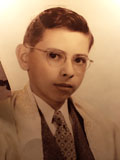


Sayeeda Zain, Ph.D. (1944 - 2012)
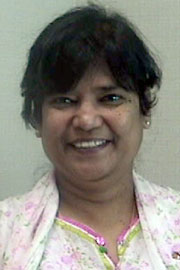
Sayeeda Zain, Ph.D.
Longtime Biochemistry & Biophysics member, Sayeeda Zain, Ph.D. passed away in late November after a long and courageous battle with cancer.
Sayeeda did her Ph.D. work at Glasgow University, Scotland then came to USA to work with Sherman Weissman in the Dept of Human Genetics, Molecular Biophysics and Biochemistry at Yale University where she carried out some of the very earliest and pioneering nucleic acid sequencing experiments, determining the sequence of parts of the SV40 virus. She then took a position at The Cold Spring Harbor Laboratories where she collaborated with Richard Roberts' group, by applying her knowledge of sequencing to both adenovirus transcripts and genomic DNA. Through these efforts, she co-discovered, with Louise Chow, the phenomenon of mRNA splicing. Roberts later received the Nobel Prize for this work, with Philip Sharp (Nobel Prize in Physiology or Medicine, 1993).
In 1978 Sayeeda took a faculty position in the Microbiology Department at the University of Rochester and later was hired into to the Biochemistry Department by Fred Sherman. Sayeeda's research program focused on eukaryotic gene expression with specific emphasis on proteins involved in Alzheimer's disease and molecular mechanisms of metastasis. She collaborated with industry as well as other leading research institutions in the US and abroad, and licensed her transgenic mice and antibodies research. She is named co-inventor on six US Patents and several foreign patents. She remained an active member of the department, teaching in Molecules-to-Cells, until last year.
For more information about Dr. Zain's research program see here.
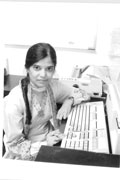
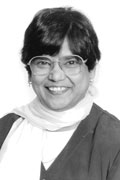
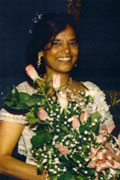
Drs. Thomas and Karlene Gunter
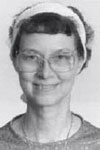
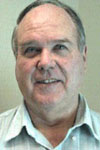
Dr. Thomas Gunter, an esteemed member of the Departments of Biochemistry and Biophysics of the University of Rochester Medical Center for nearly 55 years passed away on February 17, 2024. Dr. Gunter was an outstanding teacher, scientific mentor and researcher who made major contributions in fields ranging from control of cellular metabolism to magnetic resonance spectroscopy.
Dr. Gunter was born in 1938 in Montgomery, Alabama to a family who prioritized education. He excelled at school, eventually earning a scholarship to the Massachusetts Institute of Technology. Inspired by the German scientists with whom he grew up near Huntsville, Alabama, his initial wish was to build rockets. However, when he saw first-hand the devastating impact of war on his family, he chose instead to pursue basic physics and, eventually, biophysics. He received his Ph.D. in physics at the University of California, Berkeley performing fundamental studies using electron paramagnetic resonance. After pursuing post-doctoral research at the Lawrence Radiation Laboratory (now called the Lawrence Berkeley Laboratory) and at the Fysikalisk-Kemiska Institutionen, in Uppsala, Sweden, Dr. Gunter was first appointed as an assistant professor in what was then the Department of Radiation Biology and Biophysics at the University of Rochester in 1970.
Dr. Gunter’s expertise in measuring ion concentrations in cells and in sub-compartments of cells allowed him to make major advances in discovering how energy production in mitochondria is regulated by ions. Much of his work focused on the role of calcium transport into mitochondria via a transporter that has only recently been characterized at the molecular level. Another major aspect of his work was understanding the mitochondrial permeability transition pore, a breakdown of mitochondrial membrane barriers that is implicated in multiple medical conditions, including neurodegenerative disease and recovery from heart attacks, but that is still only poorly understood at the molecular level. Dr. Paul Brookes, a fellow faculty member at the University of Rochester, called Dr. Gunter “a giant in the field of mitochondrial biology, studying things well before other people realized how important they were!”
In addition to his role as a researcher, Dr. Gunter was a devoted teacher and mentor to students in his laboratory. Dr. Brookes recalls, “He had a real knack for explaining complex phenomena in simple terms, and would always make time to discuss things. One of Dr. Gunter’s former students, Dr. Roman Eliseev, who is now a faculty member at the University of Rochester Medical Center moved from Russia to Rochester for the express purpose of working in the Gunter laboratory. He recalls, “I wanted to be a part of Tom Gunter’s lab and never regretted my decision… Tom brought his physics background to the field of biology and was able to produce an extremely successful fusion of disciplines.” Dr. Eliseev also says that, “For me, Tom was much more than a research mentor. His brilliant mind, vast knowledge, and erudition were a constant source of fascination for me. We would start talking about science and end up discussing ancient human migrations and linguistics, US and world history, politics, humanities- these are just a fraction of his interests. And his knowledge in all these disciplines was very thorough. I am forever thankful to Tom for his guidance and friendship.”
Dr. Gunter married his college sweetheart from MIT, Karlene Klages. Karlene also went on to receive her Ph.D in physics at Berkeley working with Nobel Prize winner Glenn Seaborg at a time when few women pursued this type of training. Tom and Karlene were partners in research for almost 60 years until Karlene’s death in 2020. Together, they enjoyed numerous expeditions into the natural world, including mountain climbing and kayaking and raised a close-knit family, including three devoted daughters and five grandchildren.
Dr. Gunter’s overwhelming good nature, sense of humor, and many contributions to the teaching and research activities of the Department of Biochemistry and Biophysics will be sorely missed.
Russell Hilf, Ph.D. (1931 - 2025)
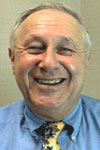 Dr. Russell Hilf had a 65 year career in biomedical sciences that culminated in an over 50-year career at the University of Rochester.
Dr. Russell Hilf had a 65 year career in biomedical sciences that culminated in an over 50-year career at the University of Rochester.
He received his BS in chemistry from the City College of New York in 1952, and his PhD in Biochemistry from Rutgers University in 1955. Following that, he held several positions including Chief, Chemistry Division, 6th US Army Medical Laboratory, Ft. Baker, CA (1955-1958), Head, Biochemistry Lab, Armed Forces Quarter Master Food & Container Institute, Chicago, IL (1959), and Head of the Cancer Endocrinology Section of the Biochemical Pharmacology Department, Squibb Institute for Medical Research, in New Brunswick, NJ (1959-1969). He also held an appointment as an Assistant Professor at Long Island University (1964-1968).
In 1969, he took a position as an Associate Professor at the University of Rochester Medical Center. He was promoted to the rank of Professor in 1976, then served as Acting Chair of the Biochemistry Department from 1980 to 1982 and as the Director for Basic Science in the URMC Cancer Center from 1993 to 1999.
Russ taught in a wide range of biochemistry, and pharmacology courses while at UR, and mentored 15 PhD students and 9 postdoctoral fellows in his laboratory. His research interests included estrogens, antiestrogens and associated receptors, hormonal regulation pathways, and anti-cancer photodynamic therapies. During his 43 years of active participation in teaching and research in the Departments of Biochemistry and Biochemistry & Biophysics his lab was funded by numerous grants from the American Cancer Society, the Department of Public Health Services, and the National Cancer Institute. He published over 225 original research papers and 40 review articles or book chapters.
Russ served on numerous NIH study sections and national/international review panels, and was appointed to multiple national health advisory panels. He served on the editorial boards of many journals, including Cancer Research and Cancer Communications, and was an elected fellow of the American Association for the Advancement of Science, and the NY Academy of Sciences.
After retirement in 2011, Russ continued to contribute to the University, serving and as a member of the University Committee on Animal Resources and as Director of the URMC Interim Grant Funding Program.
In 2017, The American Society for Biochemistry and Molecular Biology recognized Russ’s 50 year membership in its society in its monthly magazine. The publication tracking service Research Gate noted that a 1976 article by Hissin and Hilf published in Analytical Biochemistry entitled titled “A Fluorometric method for determination of oxidized and reduced glutathione in tissues” reached 1000 ‘reads’ and that thus far he has accumulated over 10,000 citations of his published research papers.
Russ was an exceptional scientist, colleague, vibrant raconteur, and friendly and good-spirited presence in the Department of Biochemistry and Biophysics, who was never at a loss for a good word.
William Simon, Ph.D. (1929 - 2022)
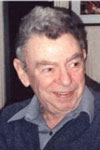 William "Bill" Simon passed away on Monday evening, April 4, 2022, after a long illness. He was born May 27, 1929 in Pittsburgh, PA to Eva Grabowsky Simon and Ike Simon. He attended Taylor Allderdice High School in Pittsburgh. By means of an academic scholarship and a job in a lab he put himself through Carnegie Tech, graduating in 1950. After college he borrowed tuition money from his older sister and brother which enabled him to attend Harvard University, earning his PhD in applied physics in 1958.
William "Bill" Simon passed away on Monday evening, April 4, 2022, after a long illness. He was born May 27, 1929 in Pittsburgh, PA to Eva Grabowsky Simon and Ike Simon. He attended Taylor Allderdice High School in Pittsburgh. By means of an academic scholarship and a job in a lab he put himself through Carnegie Tech, graduating in 1950. After college he borrowed tuition money from his older sister and brother which enabled him to attend Harvard University, earning his PhD in applied physics in 1958.
Following graduate school he briefly worked on sonar signaling at the Pentagon, and then landed at MIT Lincoln Laboratory in Lexington, MA where he met his wife Maxine. At Lincoln he participated in building the first small lab computer, the LINC. From there his interest in applying computers to laboratory and problems took off, leading to a grant to work at Harvard Medical School's Department of Physiology applying the LINC to biological research. In 1968, he was hired by the University of Rochester Medical School where he taught classes in math and physics, as applied to medicine, and counseled researchers. During his 48 years at the University of Rochester, he authored or co-authored over 60 peer reviewed articles on such varied topics as long term behavioral toxicity of methylMercury to questions of stem cell transplantation for chronic myelogenus leukemia. He was especially proud of his book, "Mathematical Techniques for Physiology and Medicine."
Bill loved Sherlock Holmes stories, sailing on the Charles River in Boston, his children and his cats, his nightly walks around Cobb's Hill, and fixing anything which allowed him to tinker in his shop.